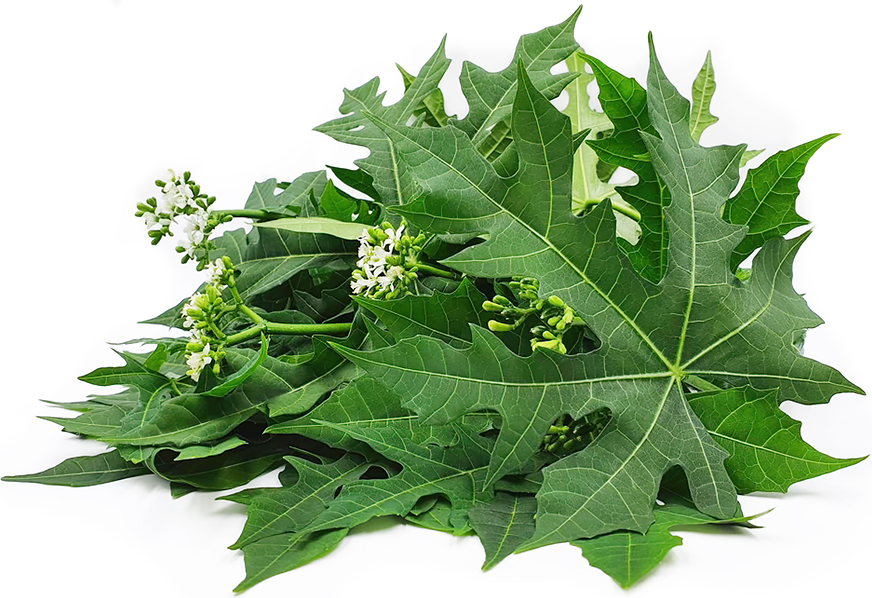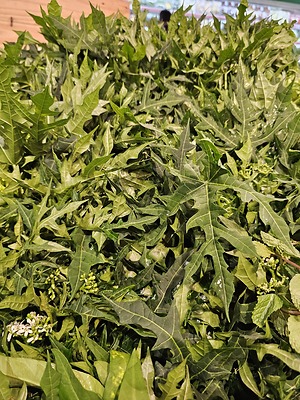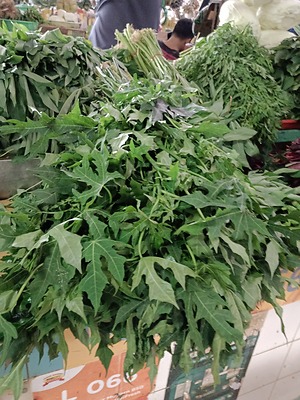


Gedi Leaves
Estimated Inventory, lb : 0
Description/Taste
Gedi leaves are dark green leaves that are maple-like in shape. They are long and "fingered", with jagged edges that end in points. Each leaf may grow to 25 centimeters in length. They appear on juicy, single stems on the Gedi plant, which is an annual plant with a trunk that grows to a height of 1.2 to 1.8 meters. Both the stems and leaves exude a sticky sap when cut. The tender young tops of the plant are harvested, as these tend to be produce less sap. Gedi leaves are fairly firm. They have a mild, pleasant, slightly bitter taste that may be described as a cross between spinach and seaweed.
Seasons/Availability
Gedi leaves are available year-round.
Current Facts
Gedi leaves are botanically classified as Abelmoschus manihot L, in the Malvaceae or mallows family. It is commonly known as Edible Hibiscus because it produces hibiscus-like flowers. Gedi leaves refer to a commonly-found variety found in Indonesia and Sulawesi, where they are used as a vegetable. They may be slimy in texture when cooked, since they are related to okra. However, Gedi leaves are prized since they are an exceptionally tasty, high-yielding plant.
Nutritional Value
Gedi leaves contain protein, iron, calcium, magnesium, manganese, potassium, amino acids, vitamin A, vitamin C, and antioxidants. Studies have shown that they have analgesic, anti-inflammatory and anti-convulsant effects.
Applications
Gedi leaves may be used raw in salads like lalab, where they provide a textural crunch. They are most commonly used sauteed like spinach, or in soups and and stews. They do produce an okra-like, mucousy sap, which is enjoyed in some cultures and used as a thickening agent for soups and sauces. However, Gedi leaves may be roasted, and will produce less sap in such applications. Gedi leaves are commonly paired with coconut milk or cream, butter, chiles, onions, garlic, and lemon juice. To use Gedi leaves, first remove the leaf from the stalk. Chop into smaller pieces, and eat raw or cooked. If cooking, they need no more than 5 to 7 minutes before softening and becoming tender. Like most leafy vegetables, Gedi leaves are highly perishable. To store them, tie them into bunches and place them in a loose plastic wrapping or a ventilated bag (in rural populations, they may be wrapped in banana leaves). Store in the refrigerator, where they will last for up to 2 days.
Ethnic/Cultural Info
Gedi leaves are known as Bele in Fiji, as Aibika in Papua New Guinea, as Slippery Cabbage in the Solomon Islands, and as Duan Pepaya Jepang (Japanese Papaya leaves, so-called because they look similar to papaya leaves) in Indonesia. Gedi leaves are used in traditional medicine in Indonesia, where they are said to help with ulcers. In Papua New Guinea, it is said to help cure colds, sore throats, skin rashes, stomach upsets, and even diarrhoea. It is used as a first food for babies, since it is easily digestible as it does not have a high fiber content. The leaves are boiled and mashed with root vegetables, and fed to infants.
Geography/History
Gedi leaves grow in the tropics. The Gedi plant is genetically diverse, and there have been some 70 varieties recorded in Papua New Guinea alone, and have been found growing in Indonesia, Sri Lanka, China, Southeast Asia, Papua New Guinea, Vanuatu, Fiji, northern Australia and China. They are used most often in Papua New Guinea, Indonesia, and the South Pacific Islands. The origins of the Gedi plant are unclear. However, it is thought that they first grew in the New Guinea region, spreading to other parts of the Pacific and then to other parts of the world through migration. Gedi leaves are found in subsistence gardens, and at local markets in its native areas.
Recipe Ideas
Recipes that include Gedi Leaves. One









